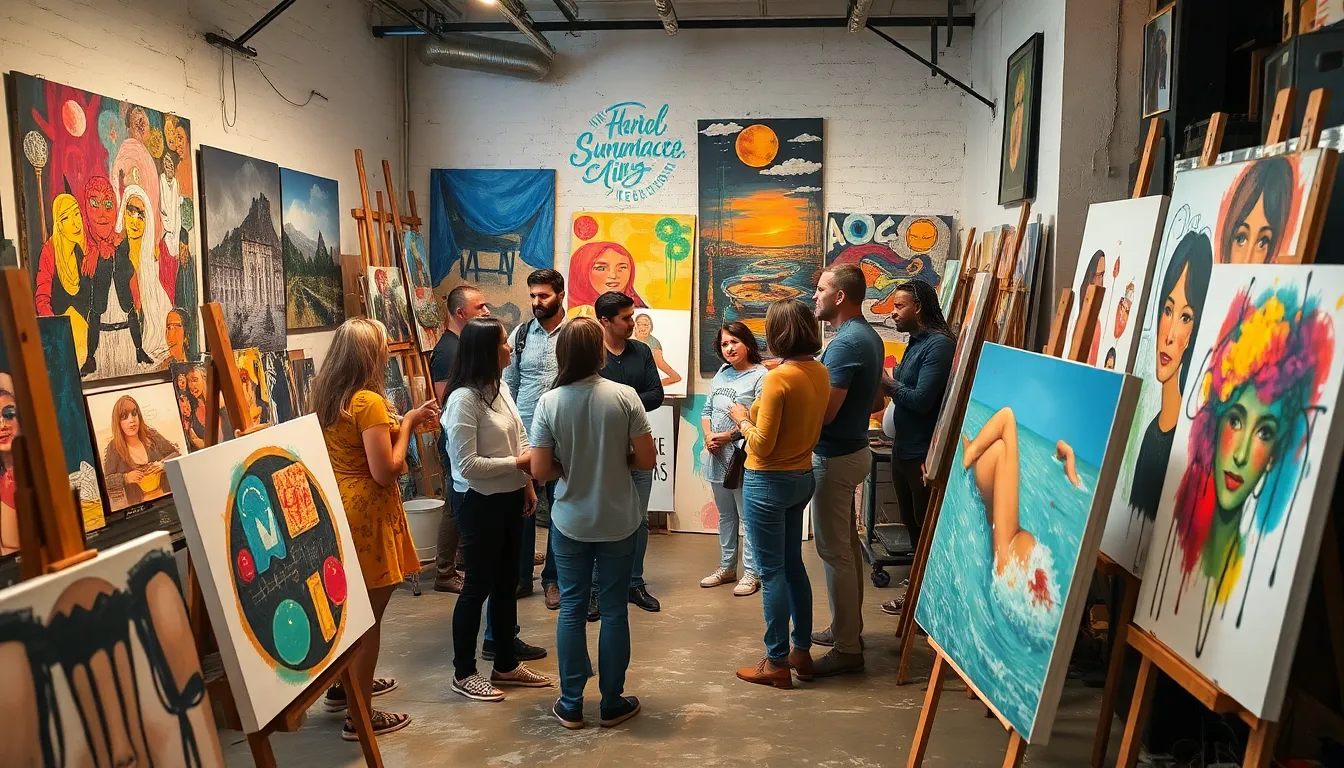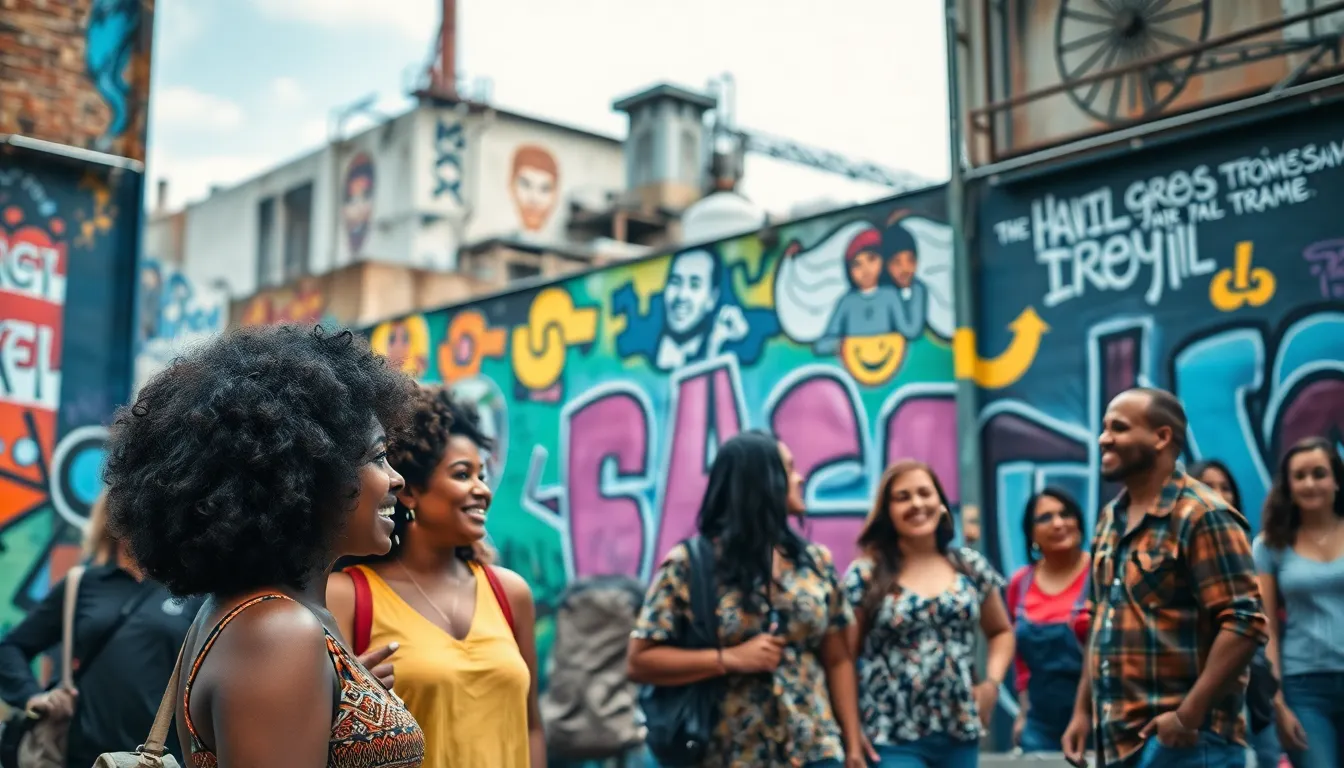In a world where everyone’s a critic and every doodle can spark a debate, the art scene is more vibrant than ever. From street murals that tell stories to galleries showcasing the next big thing, art isn’t just for the elite anymore. It’s for everyone—yes, even that friend who thinks a stick figure is a masterpiece.
Dive into the colorful chaos of creativity where passion meets paint, and every brushstroke has a tale to tell. Whether you’re an aficionado or just someone who enjoys a good Instagram scroll, the art scene offers a delightful mix of inspiration and amusement. So grab your beret and prepare to explore a world where the ordinary becomes extraordinary, and laughter is just as important as the canvas.
Table of Contents
ToggleOverview of the Art Scene
The art scene today reflects a dynamic landscape filled with diversity and innovation. Artists from various backgrounds now create and exhibit work in untraditional spaces. Community engagement thrives, with initiatives promoting accessibility for all. Street art contributes significantly, transforming urban environments into open-air galleries.
Emerging artists often utilize social media platforms to share their work and connect with a broader audience. Gallery spaces are becoming more inclusive, showcasing underrepresented voices. DIY art collectives emerge, offering alternative exhibition opportunities for those outside mainstream systems.
Events like art fairs and open studio weekends encourage interaction between artists and the public. These gatherings foster connections, highlighting the importance of community in the contemporary art scene. Local organizations often support artist residencies, enabling creators to develop their practice while contributing to the locality.
Art education programs in schools and community centers promote early engagement with creativity. Efforts to demystify art help to inspire younger generations. Regardless of their experience, individuals find value in various artistic expressions, from traditional mediums to digital formats.
Cultural institutions also adapt, providing educational resources that cater to diverse audiences. Workshops and talks often explore topics relevant to today’s society, presenting art as a medium for social commentary. The flourishing art scene encourages participation and celebrates the joy of creation in every form.
Major Art Movements

Art movements reflect the evolving creativity and cultural contexts throughout history. Understanding their characteristics enriches appreciation for today’s vibrant art scene.
Modern Art
Modern art spans roughly from the late 19th century to the mid-20th century. Artists during this period broke traditional boundaries, embracing innovation in techniques and forms. Impressionism marked a significant shift, emphasizing light and color over realistic representation. Meanwhile, movements like Cubism and Surrealism introduced abstract ideas, challenging perceptions of reality. Iconic figures such as Pablo Picasso and Henri Matisse revolutionized artistic expression. This era laid the groundwork for future movements by questioning conventions and exploring new possibilities.
Contemporary Art
Contemporary art describes work produced in the late 20th century and the present. Key characteristics include diversity in mediums and approaches, with artists using everything from installation to digital art. The boundaries continue to blur as artists address global political and social issues. Community engagement plays a crucial role, reflecting current societal challenges. Artists often collaborate, fostering connections across disciplines. Notable figures include Ai Weiwei and Banksy, who use their platforms for activism and commentary. Ultimately, contemporary art serves as a mirror of today’s world, encouraging dialogue among viewers.
Key Art Institutions
Key art institutions play a crucial role in shaping the vibrant art scene. They foster creativity, education, and community engagement.
Museums and Galleries
Museums and galleries serve as primary venues for artistic expression and public engagement. Renowned institutions like the Museum of Modern Art in New York and the Tate Modern in London showcase diverse collections, featuring both historical and contemporary works. Local galleries often highlight emerging artists, providing platforms for unique voices. Many organizations host temporary exhibitions that explore relevant themes, encouraging dialogue. Interactive installations and community events further enhance public participation. Through guided tours and educational programs, institutions cultivate appreciation for art across all age groups.
Art Schools and Institutions
Art schools and institutions nurture the next generation of creatives. Prestigious programs at institutions like the Rhode Island School of Design and the California Institute of the Arts offer comprehensive curriculums. Students engage in various disciplines, from painting to digital media, allowing exploration of innovative techniques. Mentorship opportunities connect students with established artists, fostering professional growth. Workshops and community classes enhance accessibility, encouraging local participation. These institutions also contribute to the art scene through collaborations with local organizations, ensuring that art education remains relevant and impactful.
Influential Artists in the Art Scene
Influential artists shape the art scene, showcasing diverse expressions and perspectives. Their contributions range from emerging talents to established icons.
Emerging Artists
Emerging artists redefine creativity in innovative ways. They often utilize social media for exposure, gaining recognition quickly. Street art also serves as a powerful platform, transforming public spaces into vibrant canvases. These individuals challenge traditional constraints and introduce fresh ideas. Local exhibitions give them opportunities to connect with communities directly. Their work often reflects current societal themes, encouraging dialogue among viewers. For example, recent exhibitions feature artists addressing climate change and social justice. Engagement with audiences through interactive installations elevates their presence in the art scene.
Established Artists
Established artists command significant influence within the art landscape. They bring a wealth of experience and a distinctive voice, often garnering international acclaim. Iconic figures such as Ai Weiwei and Yayoi Kusama illustrate the impact of art as activism. Their works transcend mere aesthetics, prompting critical examinations of societal issues. Museums and galleries frequently showcase their creations, drawing large audiences and inspiring emerging talents. Notable retrospectives highlight their contributions, ensuring that their legacies endure. Varied mediums and techniques characterize their portfolios, reflecting personal journeys and broader cultural narratives. These artists not only enrich the art world but also inspire future generations to push creative boundaries.
The Role of Technology in the Art Scene
Technology significantly shapes the contemporary art scene, facilitating new modes of creativity and engagement. Digital tools allow artists to explore innovative techniques and reach wider audiences. Many creators utilize software like Adobe Creative Suite and 3D modeling programs to enhance their artistic expression.
Social media platforms serve as vital channels for promotion and connection. Artists often share their work on Instagram and TikTok, engaging with followers and participating in global conversations. These platforms enable emerging talents to gain visibility and form communities without relying on traditional galleries.
Virtual and augmented reality offer immersive experiences that transform how audiences interact with art. Exhibitions can now be accessed remotely, making art more accessible than ever. Artists are increasingly integrating these technologies into installations, creating multisensory environments that captivate viewers.
Blockchain technology also impacts the art world significantly. Non-fungible tokens (NFTs) revolutionize ownership and sales, providing artists with new revenue streams. Buyers can purchase digital art secured by blockchain, ensuring authenticity and scarcity.
Art education incorporates technology to prepare students for this evolving landscape. Institutions integrate courses on digital media, 3D printing, and coding into their curriculums. These programs equip future artists with the necessary skills to thrive in a technology-driven environment.
Ultimately, technology enhances creativity and accessibility in the art scene. As artists embrace digital tools and platforms, they redefine artistic boundaries and foster broader community engagement. The intersection of art and technology continues to inspire collaboration, resulting in a dynamic and vibrant artistic landscape.
The vibrant art scene today thrives on accessibility and community engagement. It invites everyone to explore creativity in its many forms. Emerging artists and established figures alike contribute to a dynamic landscape that reflects contemporary issues and cultural shifts.
As technology continues to reshape the way art is created and consumed, the possibilities for expression expand. This ever-evolving environment not only fosters innovation but also encourages meaningful dialogue among diverse audiences.
Ultimately, the joy of art lies in its ability to inspire and connect people from all walks of life. Embracing this colorful world enriches individual experiences and strengthens community bonds.



